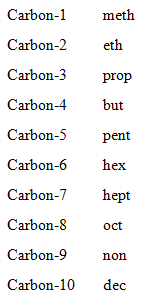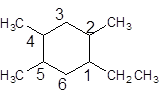
Interpretation:
The IUPAC name of the following compound should be determined:

Concept introduction:
The hydrocarbon compounds that contains single bond(s) between carbon atom(s) are said to be saturated hydrocarbon. Hydrocarbon compounds containing single bonds only are said to be
Answer to Problem 13SSC
2-methylpentane.
Explanation of Solution
In order to give the IUPAC name to the alkane following steps are followed:
1. The parent (longest) continuous carbon chain is identified.
2. The ending of the parent chain for alkane (-e) is -ane.
3. Name should be written in alphabetical order and numbering should be done in such a way that the substituent group gets lowest number.
4. Hyphen is used to connect the number to the name.
For number of carbons atoms in alkane chain, the prefix is given as:

The given structure is:

The parent chain contains 1 substituent so numbering is done in such a way that substituent gets lower number as shown:

Since, the parent chain contains 5 carbon atoms and only single bonds are present so, the parent chain is pentane. Since, the substituent,
Interpretation:
The IUPAC name of the following compound should be determined:

Concept introduction:
The hydrocarbon compounds that contains single bond(s) between carbon atom(s) are said to be saturated hydrocarbon. Hydrocarbon compounds containing single bonds only are said to be alkane.
Answer to Problem 13SSC
2, 2-dimethylpropane.
Explanation of Solution
The given structure is:

The parent chain contains 2 substituents so numbering is done in such a way that substituents gets lower number as shown:

Since, the parent chain contains 3 carbon atoms and only single bonds are present so, the parent chain is propane. Since, the substituents,
Interpretation:
The IUPAC name of the following compound should be determined:

Concept introduction:
When the carbon atoms of hydrocarbons are arranged in such a way that it results in the formation of ring then it is said to be cycloalkanes.
Answer to Problem 13SSC
1-ethyl-2, 4, 5-trimethylcyclohexane.
Explanation of Solution
In order to give the IUPAC name to the cycloalkane following steps are followed:
1. The parent (longest) continuous carbon chain is identified.
2. The prefix -cyclo is used before the name of alkane for a ring.
3. If the attached alkyl chain possesses greater number of carbon atoms, then alkyl chain is considered as primary parent chain.
4. Name should be written in alphabetical order and numbering should be done in such a way that the substituent group gets lowest number.
5. Hyphen is used to connect the number to the name.
The given structure is:

The parent chain contains a ring of six carbon atoms and 4 substituents so numbering is done in such a way that substituents gets lower number as shown:

Since, the parent chain contains a ring of six carbon atoms and only single bonds are present so, the parent chain is cyclohexane. Since, the substituents, one
Chapter 21 Solutions
Chemistry: Matter and Change
Additional Science Textbook Solutions
Introductory Chemistry (6th Edition)
General Chemistry: Principles and Modern Applications (11th Edition)
Organic Chemistry (9th Edition)
CHEMISTRY-TEXT
General, Organic, and Biological Chemistry (3rd Edition)
Chemistry: A Molecular Approach (4th Edition)
 ChemistryChemistryISBN:9781305957404Author:Steven S. Zumdahl, Susan A. Zumdahl, Donald J. DeCostePublisher:Cengage Learning
ChemistryChemistryISBN:9781305957404Author:Steven S. Zumdahl, Susan A. Zumdahl, Donald J. DeCostePublisher:Cengage Learning ChemistryChemistryISBN:9781259911156Author:Raymond Chang Dr., Jason Overby ProfessorPublisher:McGraw-Hill Education
ChemistryChemistryISBN:9781259911156Author:Raymond Chang Dr., Jason Overby ProfessorPublisher:McGraw-Hill Education Principles of Instrumental AnalysisChemistryISBN:9781305577213Author:Douglas A. Skoog, F. James Holler, Stanley R. CrouchPublisher:Cengage Learning
Principles of Instrumental AnalysisChemistryISBN:9781305577213Author:Douglas A. Skoog, F. James Holler, Stanley R. CrouchPublisher:Cengage Learning Organic ChemistryChemistryISBN:9780078021558Author:Janice Gorzynski Smith Dr.Publisher:McGraw-Hill Education
Organic ChemistryChemistryISBN:9780078021558Author:Janice Gorzynski Smith Dr.Publisher:McGraw-Hill Education Chemistry: Principles and ReactionsChemistryISBN:9781305079373Author:William L. Masterton, Cecile N. HurleyPublisher:Cengage Learning
Chemistry: Principles and ReactionsChemistryISBN:9781305079373Author:William L. Masterton, Cecile N. HurleyPublisher:Cengage Learning Elementary Principles of Chemical Processes, Bind...ChemistryISBN:9781118431221Author:Richard M. Felder, Ronald W. Rousseau, Lisa G. BullardPublisher:WILEY
Elementary Principles of Chemical Processes, Bind...ChemistryISBN:9781118431221Author:Richard M. Felder, Ronald W. Rousseau, Lisa G. BullardPublisher:WILEY





